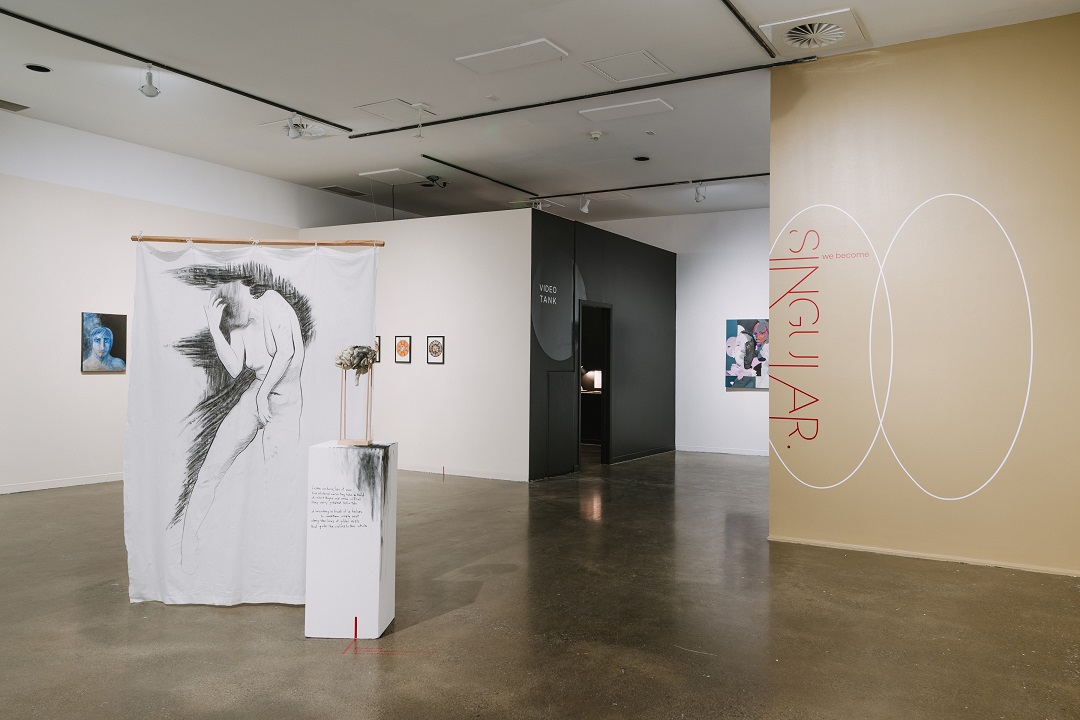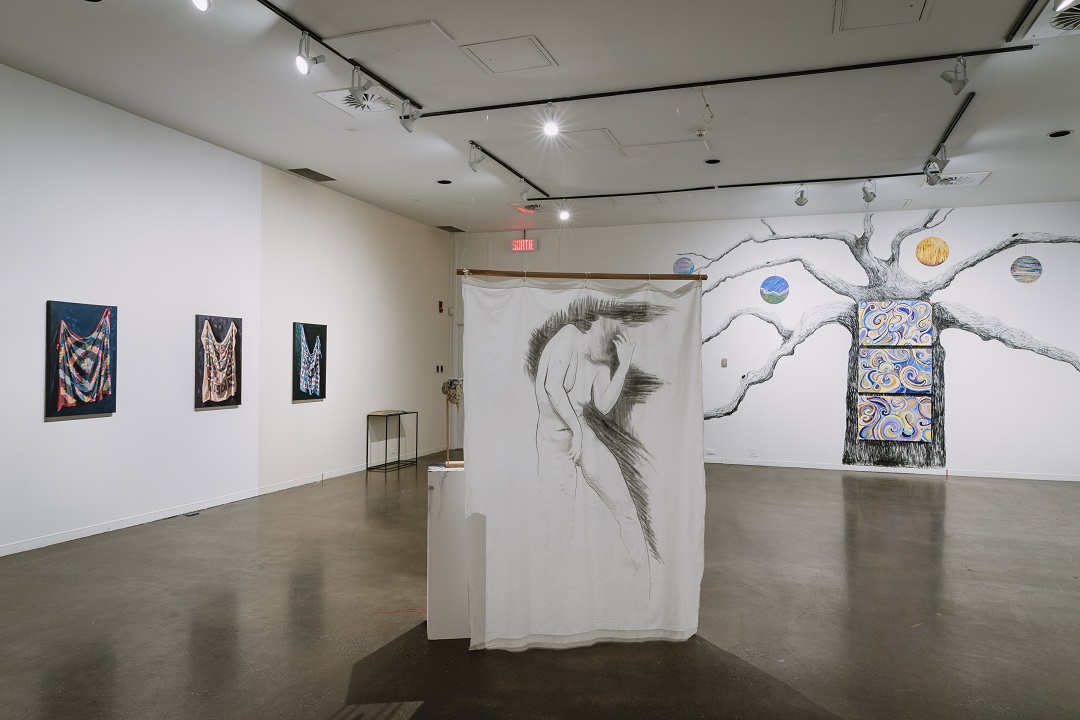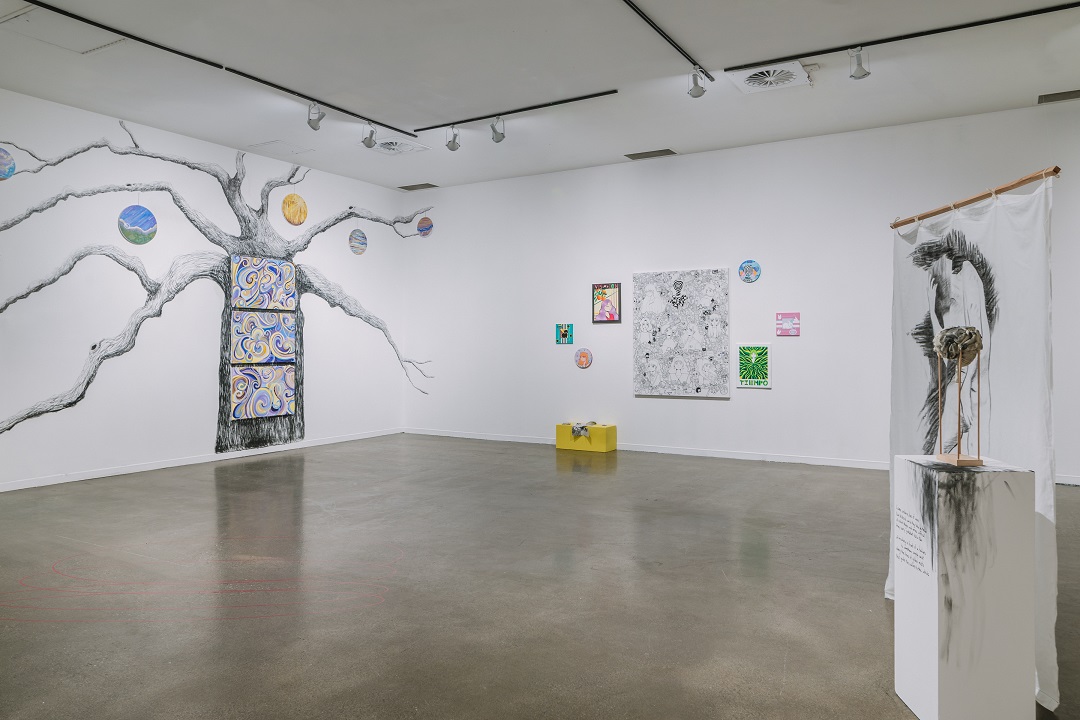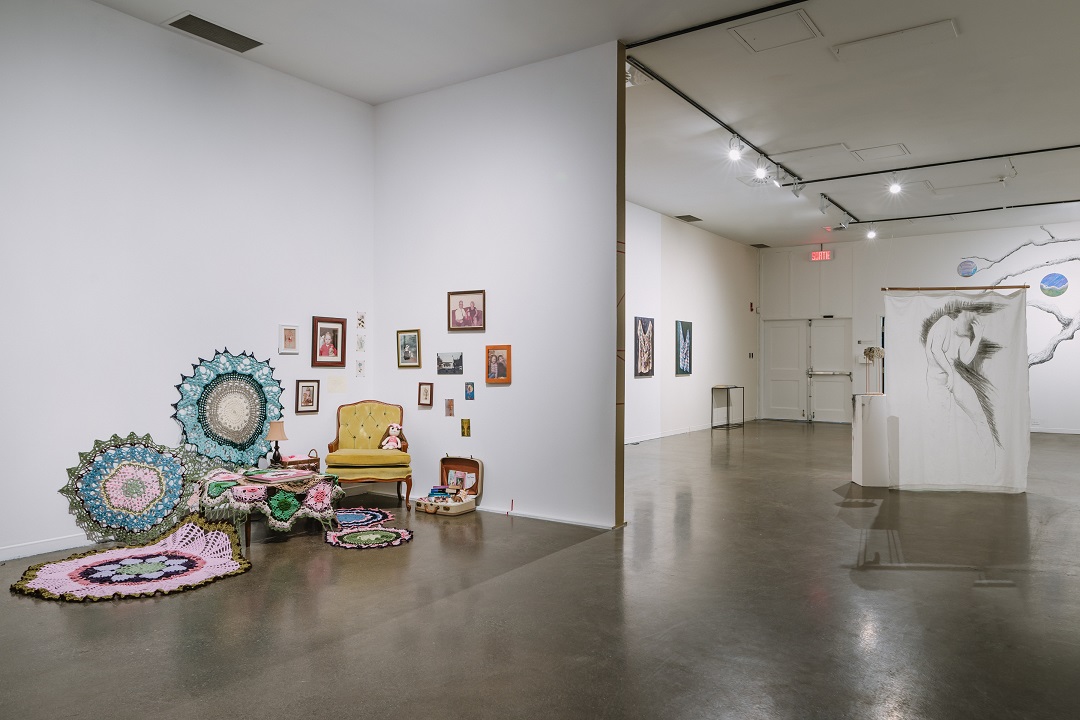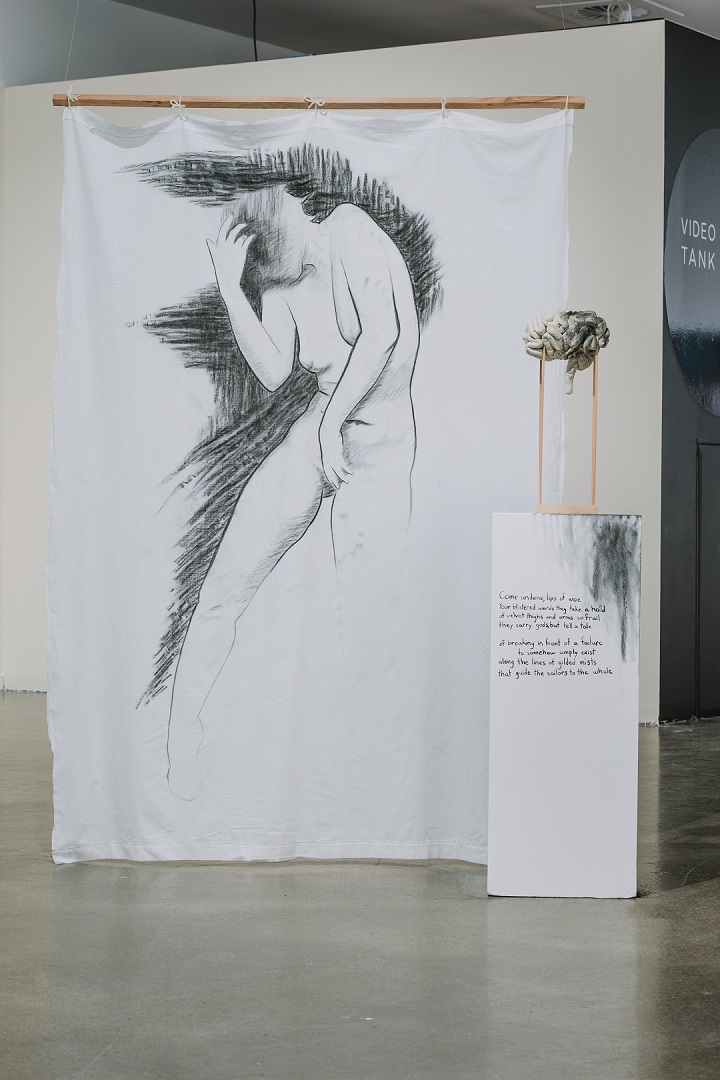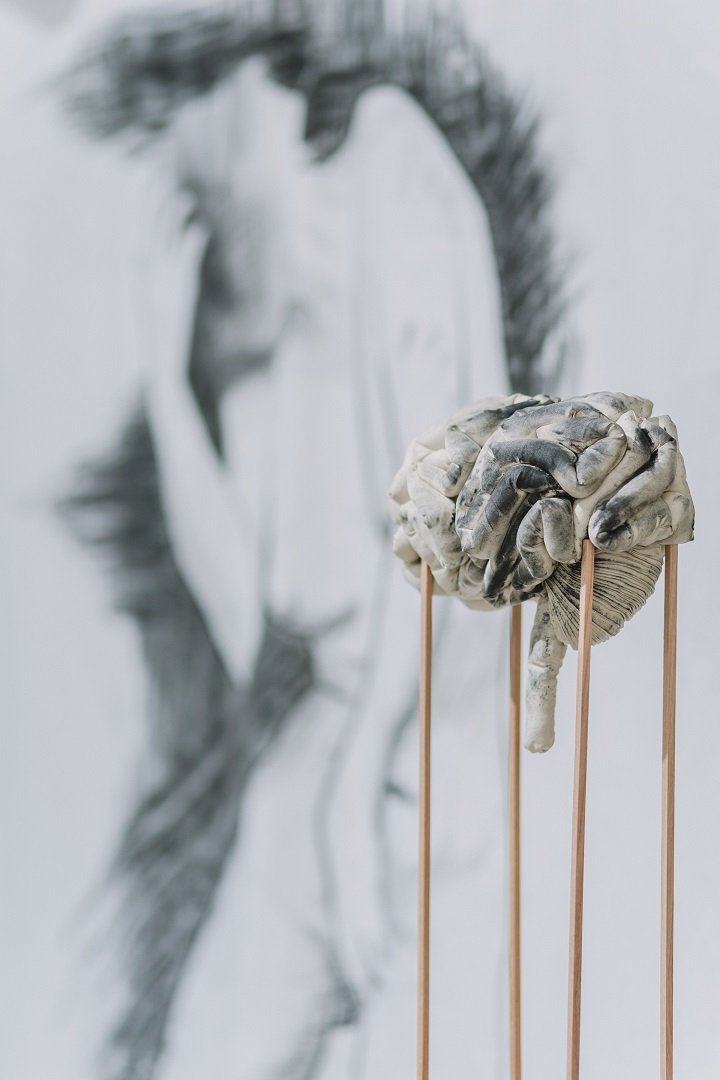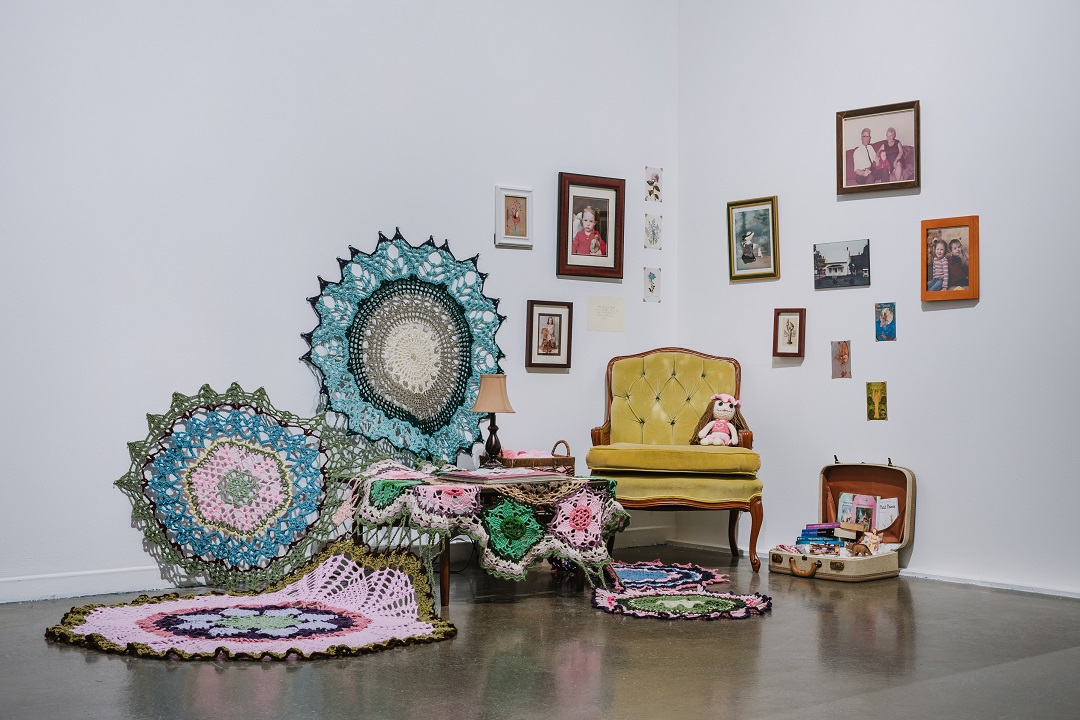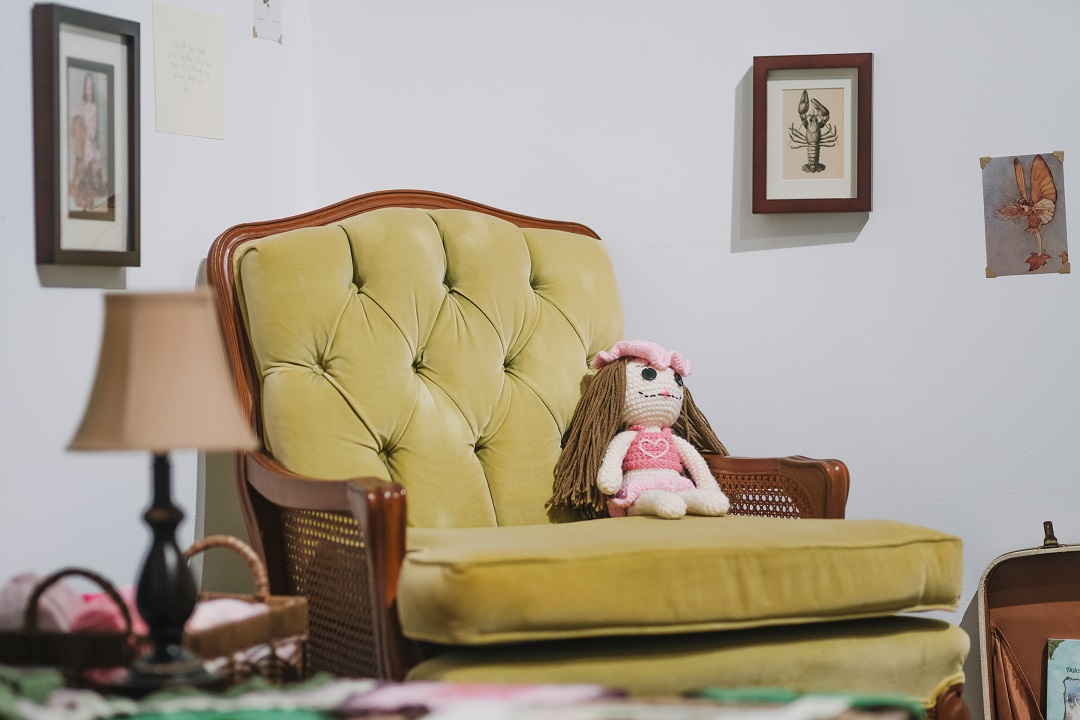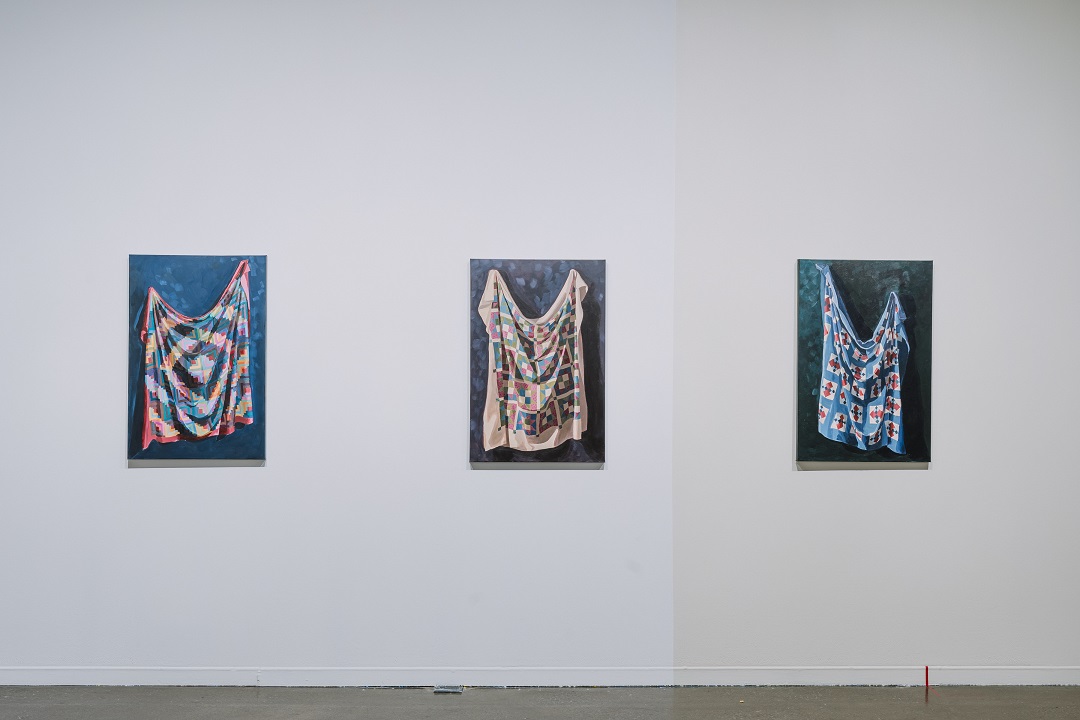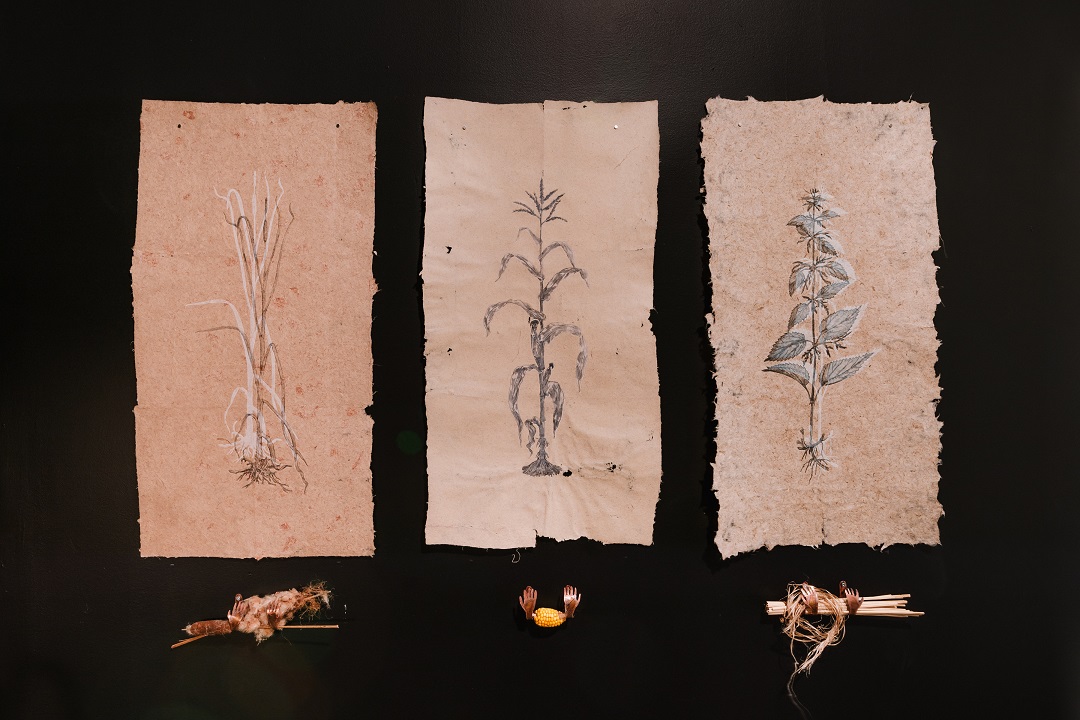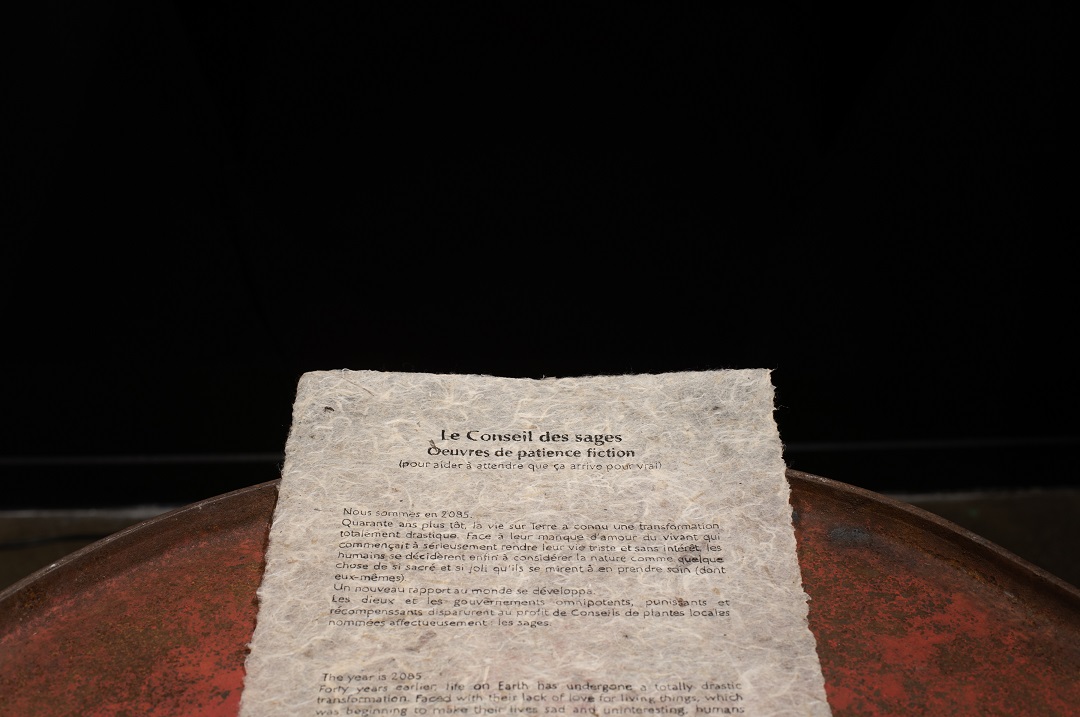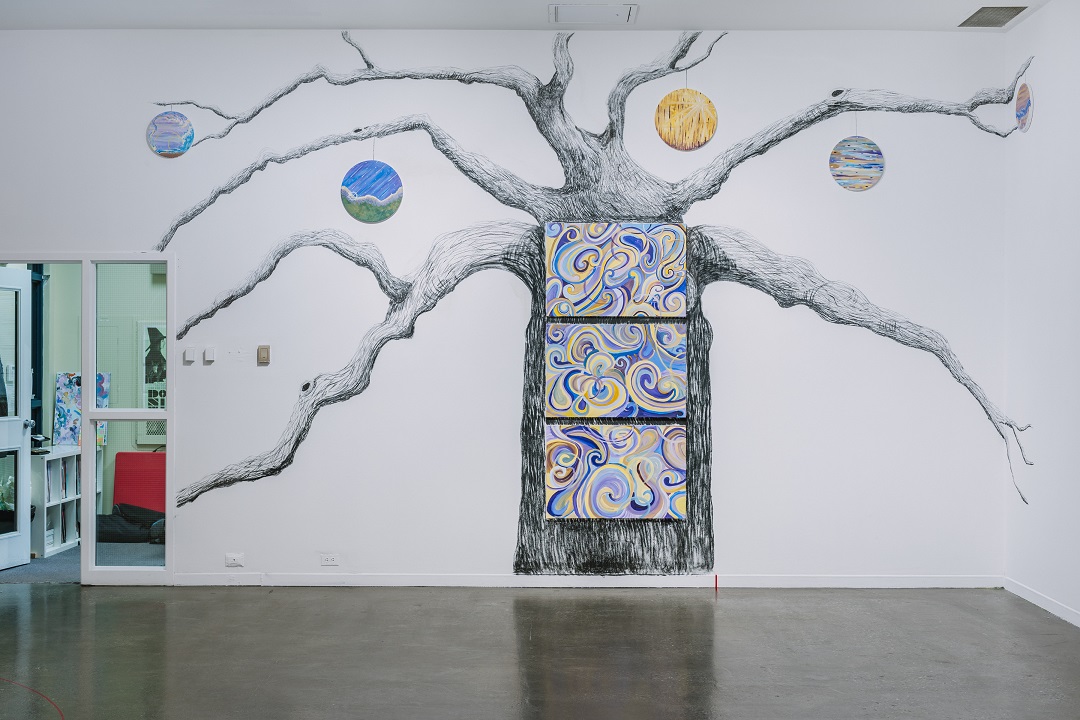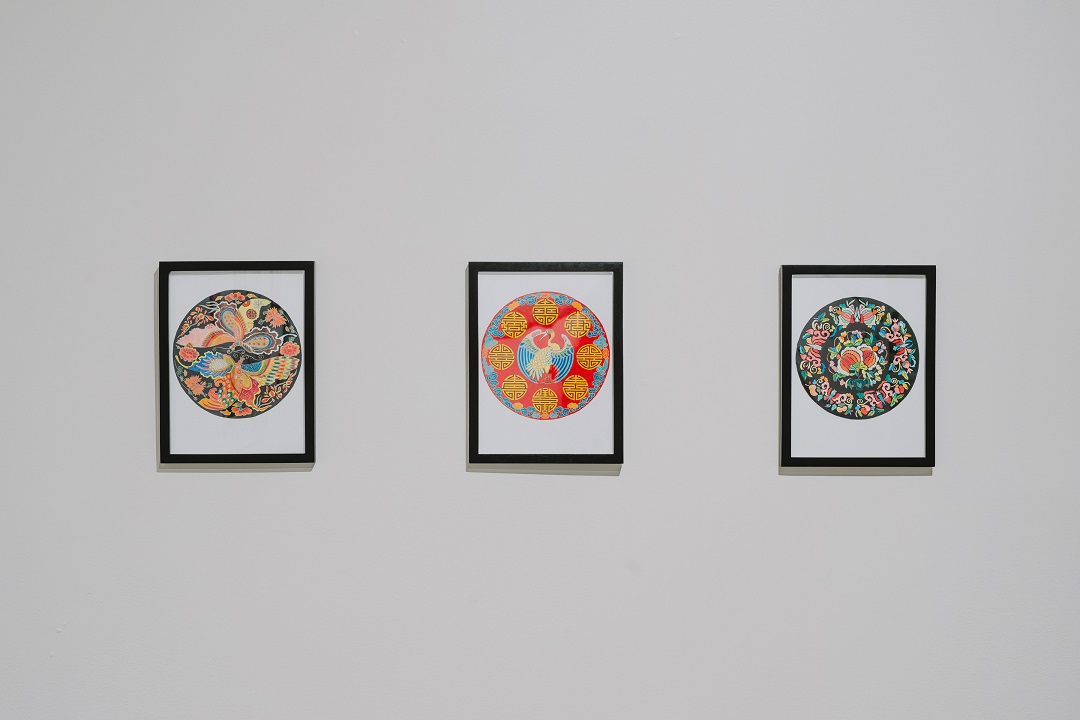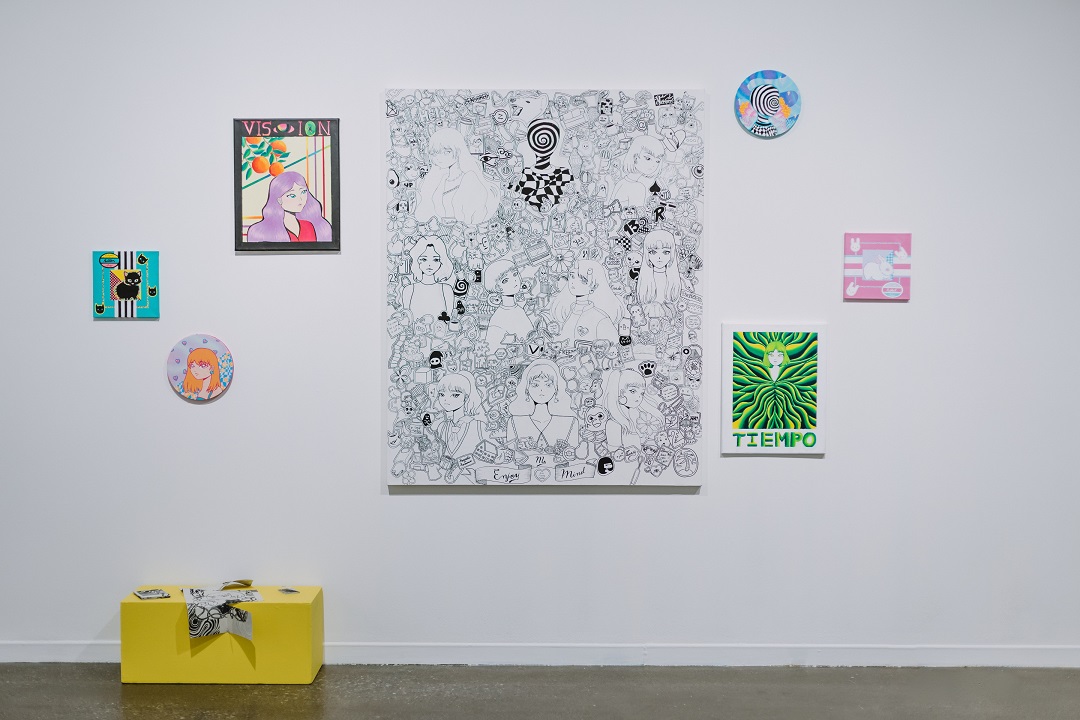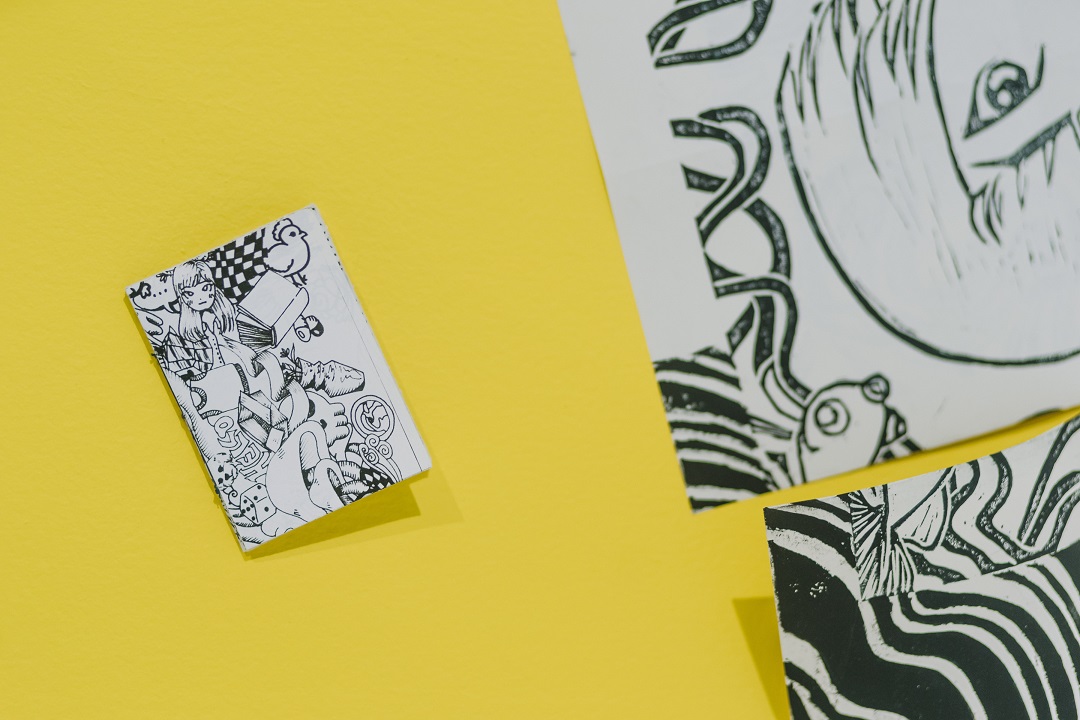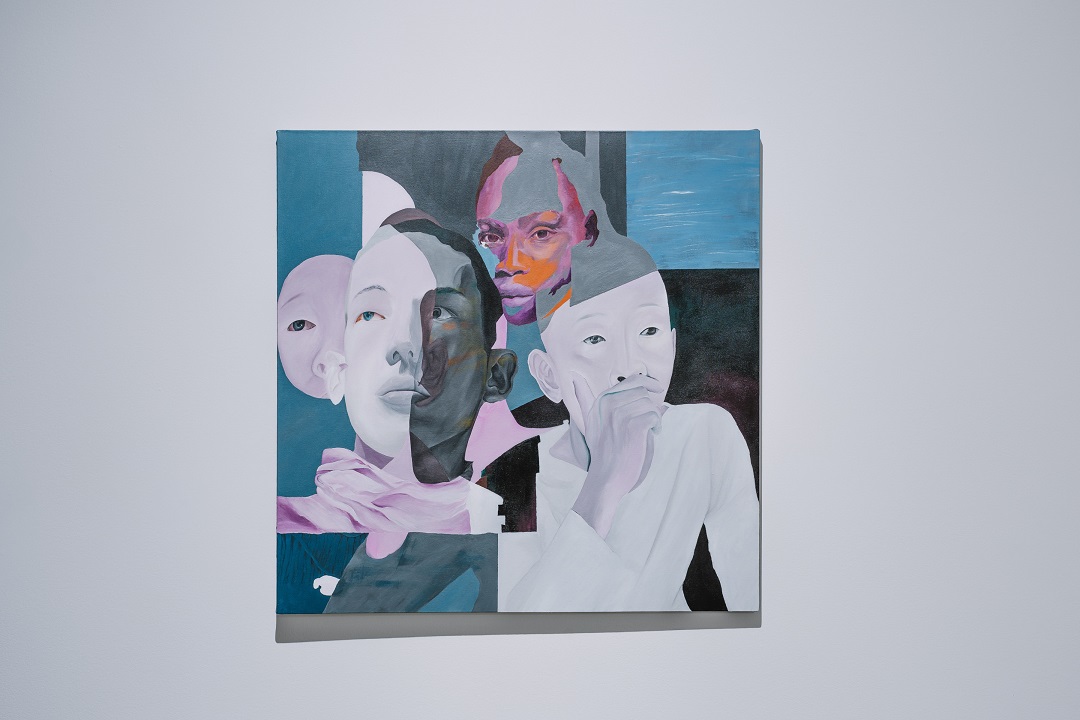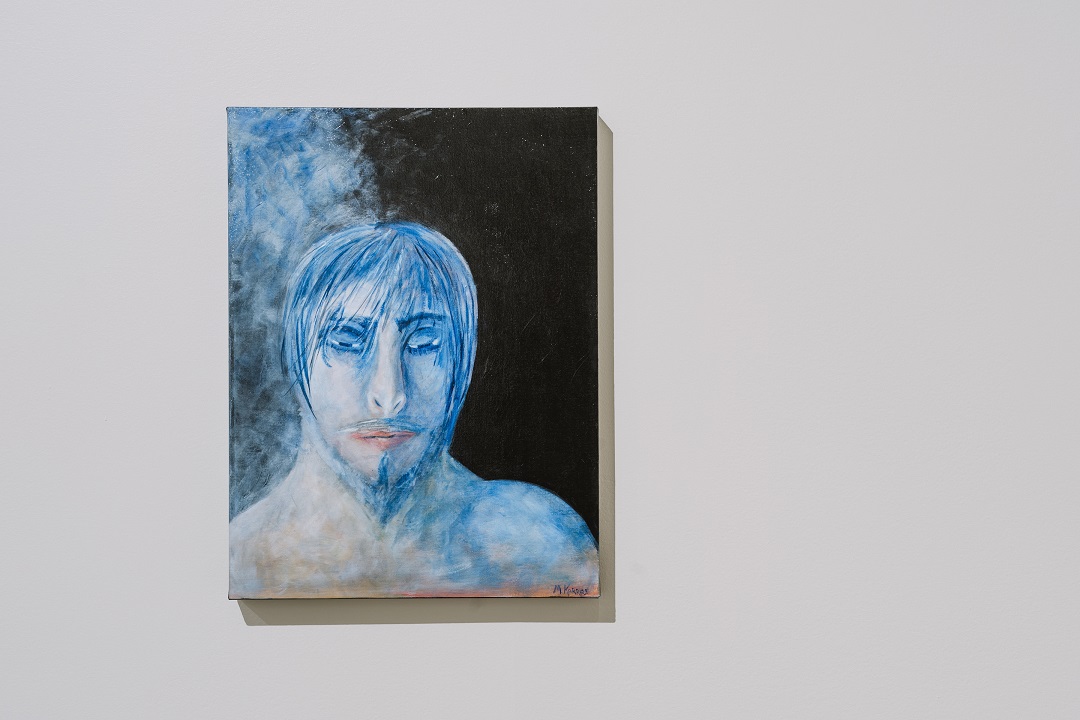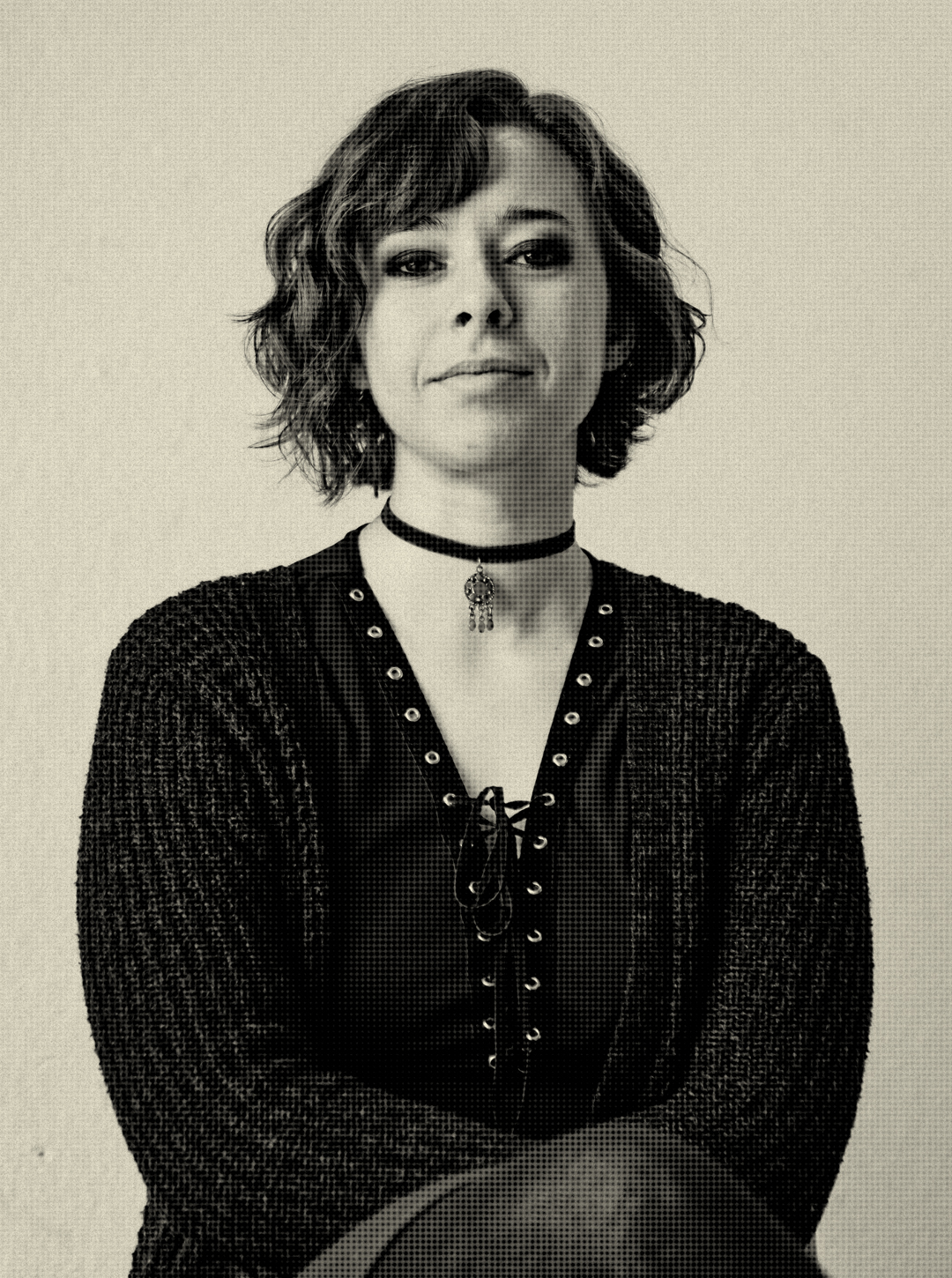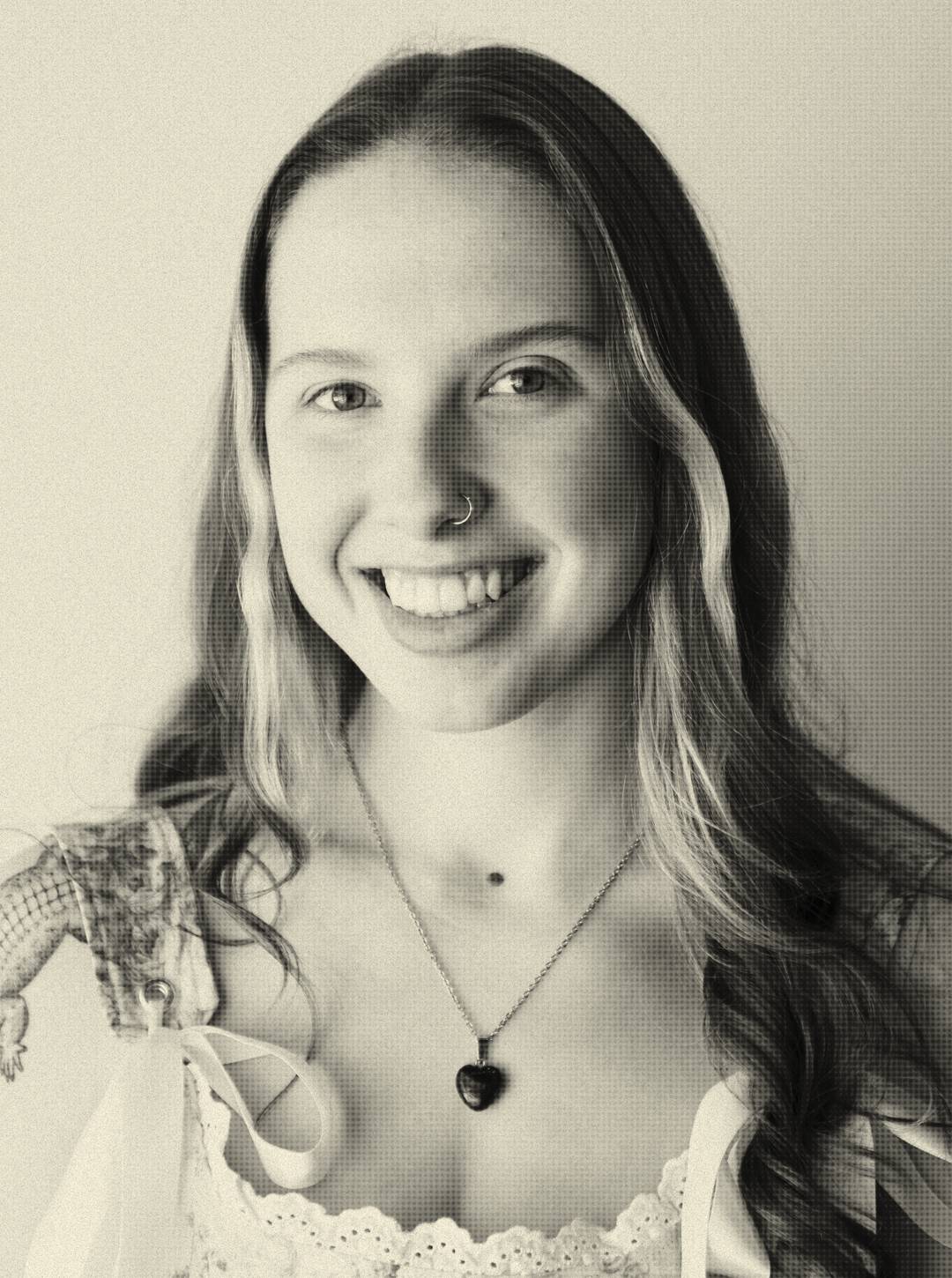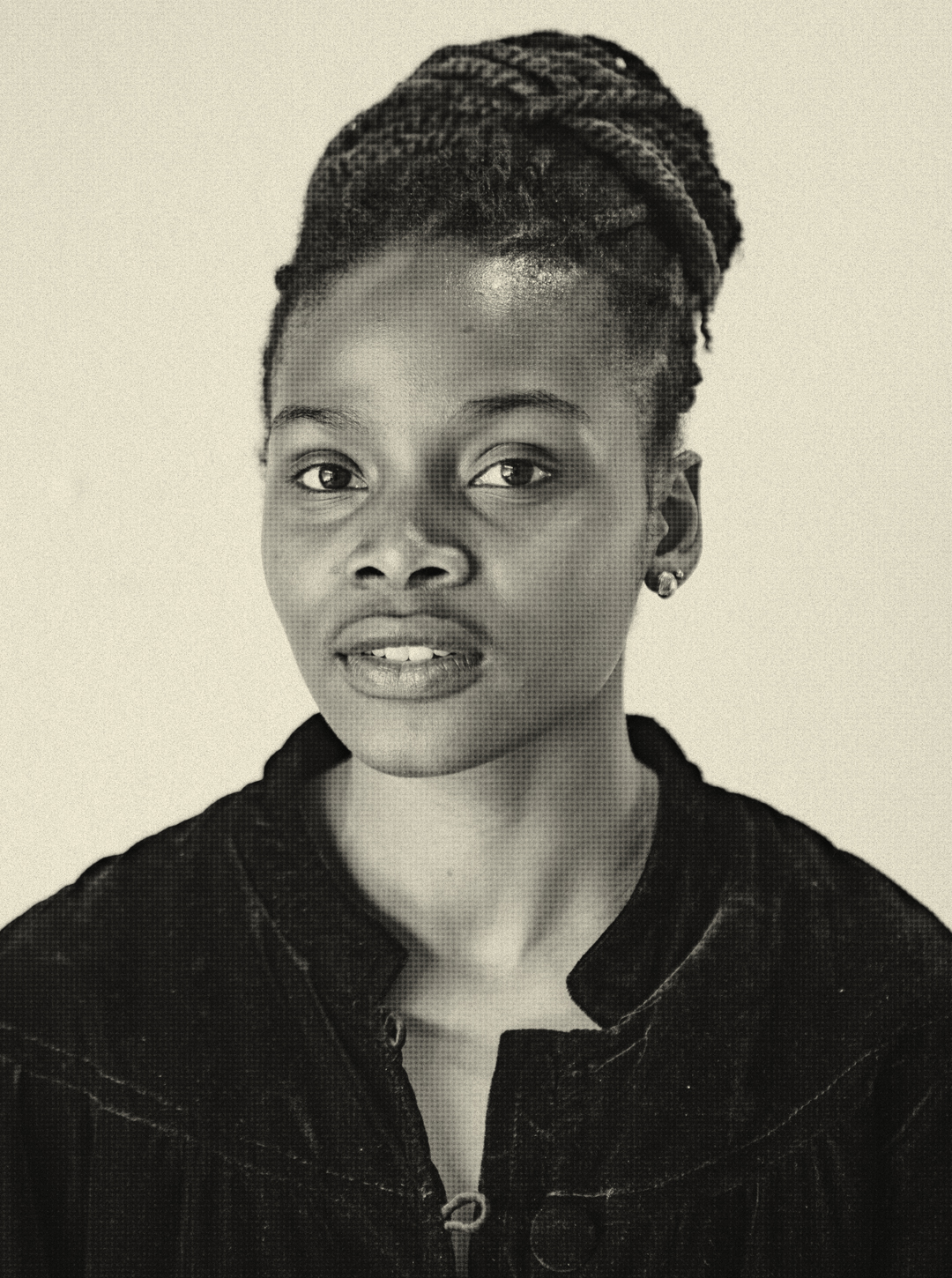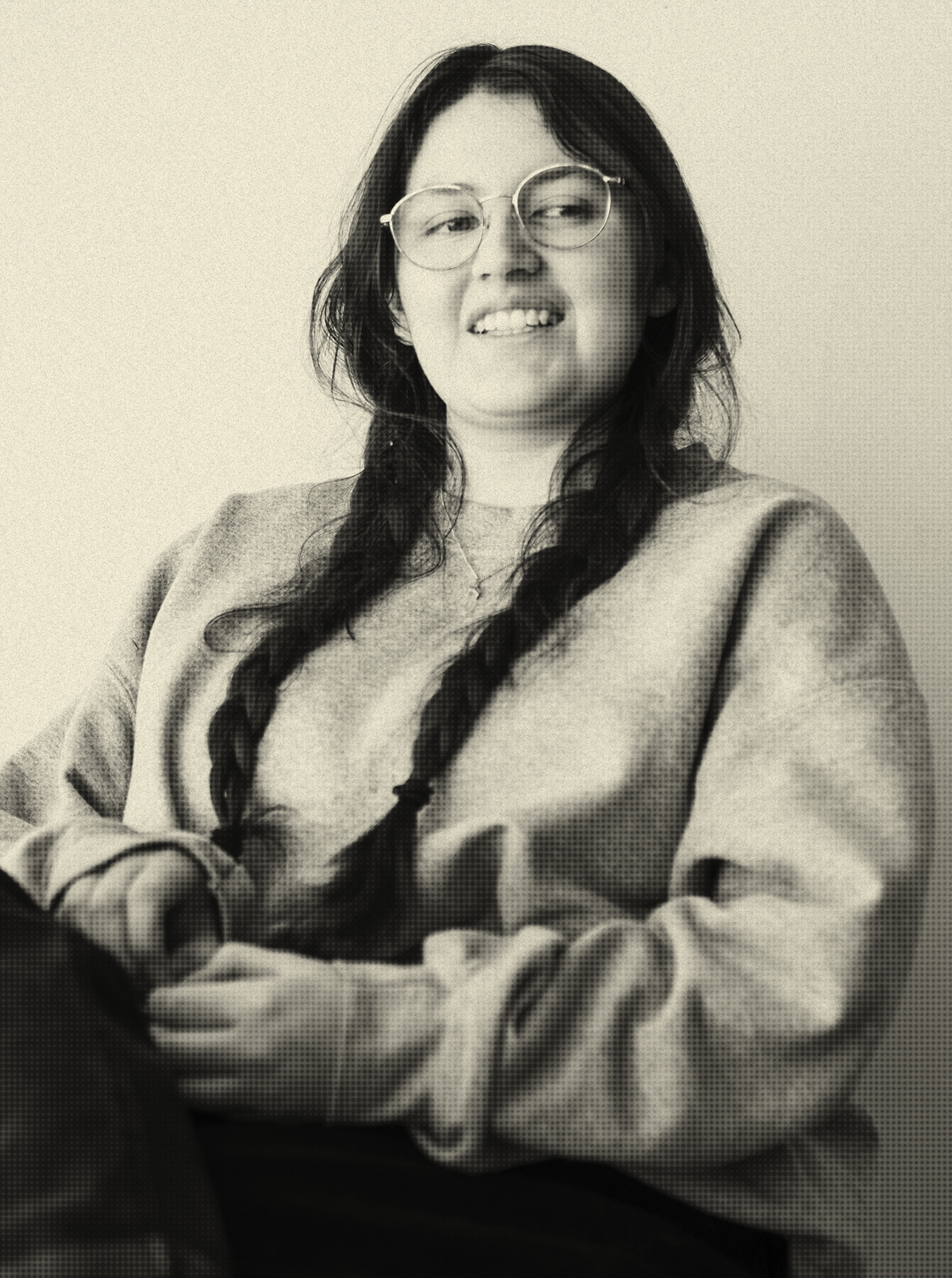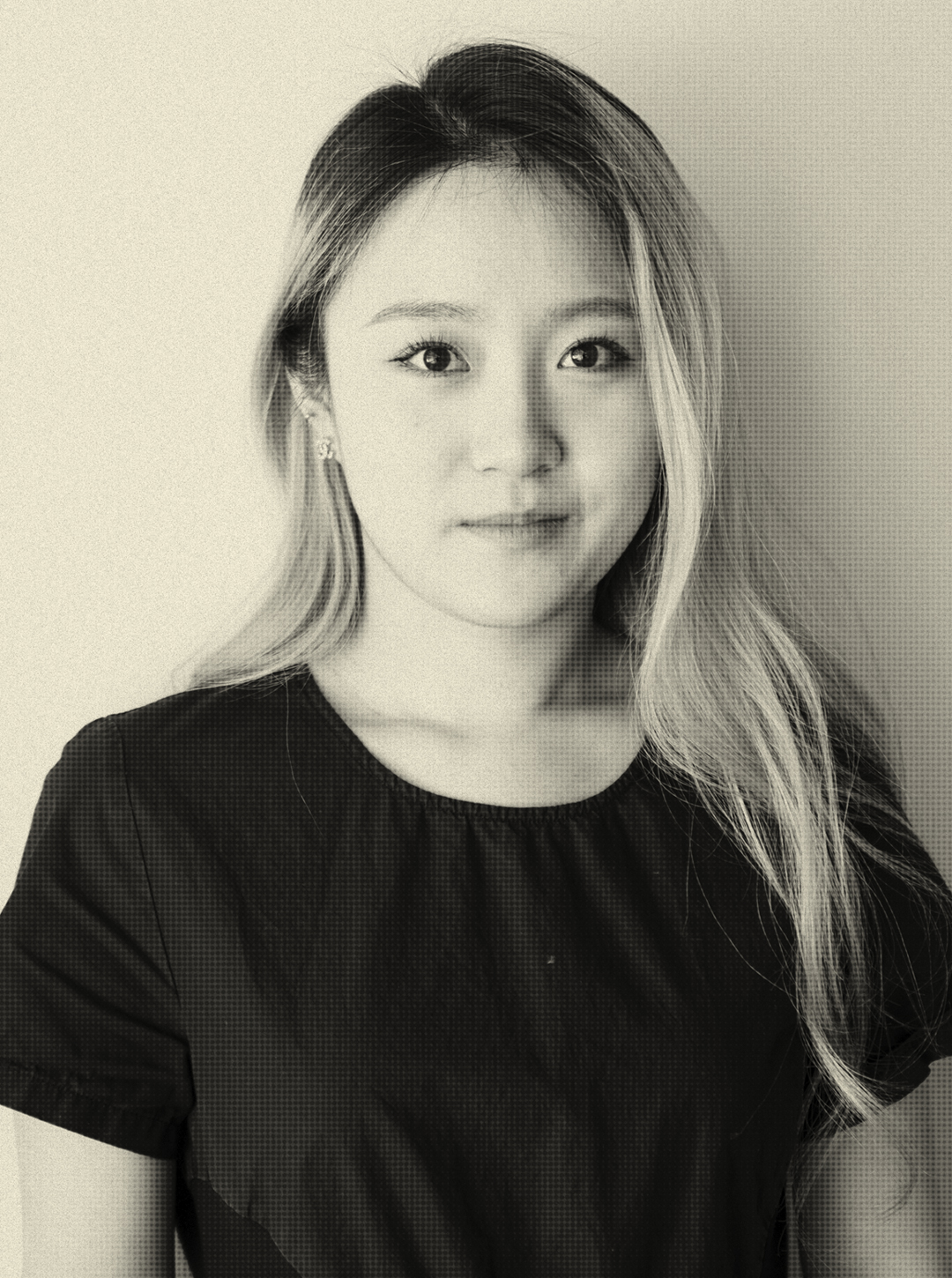In its most fundamental sense, a cycle refers to any periodically repeating sequence of phenomena. Although cyclicity implies repetition, this does not exclude novelty or change; quite the contrary. In nature, cycles are endlessly renewed even as life continues to evolve. The end of one cycle marks the birth of another, differing from its progenitor in minute yet crucial ways. Though the cycles of sun and moon never cease to repeat, each new beginning brings fresh opportunities to turn our eyes to the sky in candid reflection.
Our nine graduates brought together at the Foreman Art Gallery here in the spring of 2023 have embarked on just such a cyclical journey, where a retrospective form actually serves, paradoxically, as a leap ahead, just as a wheel spinning around its axle generates constant forward motion. Each of their projects expresses the desire to revisit a theme, a state, a known place — but from a new perspective, shaped by all that has been learned and experienced during these past years, and with the hope of creating openings that will lead to other places and other ways of being in this world.
Read more
Flexible and polysemic, cyclicity thus offers multiple lenses through which to view the movement as these projects are inscribed in each artist’s trajectory. In literature and music, cycles are collections of texts or songs centred on a theme or a heroic protagonist. The work of Michael Karras is inspired by a song cycle composed by Ralph Vaughan Williams, the Songs of Travel, a work with which he was intimately familiar as a solo singer, and which he has now reinterpreted through the prism of visual arts. Yueran Zhong, whose work is closely tied to her Chinese cultural heritage, offers traditional motifs conveying good luck and long life. Élise Grenier’s knitted installation, undertaken in order to better care for the child she once was, serves as the starting point for a new ritual cycle that will in turn generate its own traditions and memories, to be superimposed atop those passed down through family heritage.
In biology and chemistry, an element’s cycle takes it on voyages through different states and across different organisms. Water molecules constantly cycle from solid to vapour and back again, all the while maintaining a fundamental essence as recognizable in Martian mineral deposits as in a nettle’s sap. The plant fibres that serve as raw materials for Faustine Gruninger’s paper works likewise undergo a series of state changes during their passage from initial harvest to final moulding into sheets, each species cooked and every fibre extracted according to specific parameters. The plants are then given a reinvented integrity, their reconstructed portraits inscribed on their own reconstructed tissues. Fascinated by the geometry of repeating motifs, Laura Pohl transposes them across media. The configurations of grids and lozenges that make up her motifs are turned into quilts, which are in turn taken as subjects for a series of paintings inspired by Renaissance studies of draperies.
In everyday language, a cycle also refers to a series of encounters or events that share common goals or themes. In this sense, the project of each show for graduating fine arts students at Bishop’s University is itself a cyclical process, a round of negotiations, during the course of which each year’s repetition of the same steps generates very different experiences for each cohort and for each member of every cohort. It could not be otherwise, since when this cyclical process starts anew each September, it departs from terra incognita, inchoate territory forged and delimited by a unique set of circumstances — the lived experience and identity of each graduate, that of the curator, each set of interests, every temperament, that moment’s social, political, economic and ideological contexts, and the interplay of these factors across individuals and throughout the institution within which this conjuncture occurs — which never can, and never will, be exactly repeated.
An additional, oppositional force thus dwells within cycles, a constant struggle between the irresistible return of ineluctable phenomena and the potential for contingency and chaos inherent to each iteration. It is from these chance possibilities that transformation may erupt. The paintings of Nana Sani and Caleb Stemp, which carve out space for spontaneity within carefully considered and defined formal processes, draw fruitfully on this intrinsic tension. The work of Ana Maria Torres both recognizes and contests this entropic power, wrestling to tame disorder by encapsulating it time and again in her images and books. Océane Dessureault-Opalewski explores the psychological mechanisms at work in the perpetual reconstruction of self-image, an intimate representation that slowly crystallizes as it ceaselessly oscillates between objectivity and distortion.
As an iterative phenomenon, cyclicity reinforces — but what is reinforced may be beneficial just as it may be destructive. A cycle may favour growth… or violence. Cyclicity offers no inherent promise of stability or success; at most, it offers the opportunity to relive certain experiences, with the possibility for change each time. Perhaps for the better. Recognizing this movement and the constraints that bound it allows us to take back some control, as artists and individuals, over these forces that set the rhythm of our development, of our lives and those of our collectivity.
If each artist, in undertaking their creative project, has embarked on their own unique cycle, the Graduating Students’ Exhibition brings all of these together, further intersecting them with cycles of curation and institution, at a precise point that we may think of as a place, as described by art critic and theorist Steven Henry Madoff: “Place is the nexus of motion, sensation, and meaning—an aggregation of mechanisms of mobility, individual acts of cognition, and shared decisions about what we’ll tolerate, negotiate, and agree on regarding what being human means, privately and publicly.”[1] Madoff contrasts place, marked by a focused interlacing of individual and collective gestures, with mere space, undifferentiated and perpetual; as he puts it, “Place is the navigated locus, turning the fluidity of space into a site of meaning, a concentration of tasks in time that leads to understandings of our humanity […]”[2] Like a fleeting alignment of the planets, this superposition of these individual cycles will last no more than an instant as each body continues its movement, and this place where they have intersected, momentarily charged with meaning, will revert to space once these artworks depart.
In summary, we become singular. invites you to bear witness to an eclipse.
Marie-Michèle Robitaille
Notes
OCÉANE DESSUREAULT-OPALEWSKI (alias LESHACHIKHA)
In her final year studying Fine Arts with honours in Studio Art, Applied Psychology, and a concentration in Mindfulness and Contemplative Studies, Océane Dessureault-Opalewski (also known as Leshachikha) creates works that explore notions of mental health, gender identity, folklore, and fantasy.
Her practice, which mixes media such as pen and pencil, watercolour, charcoal, mixed media, and collage, has won her the Wanda Rozynska Scholarship in Fine Arts.
Versatile and curious, Océane envisions a career in constant flux that would offer her variety and flexibility.
Artist Statement
Leshachikha’s background in psychology has led her on an inquiry into mental health through expressive representations of bodies and portraits in elusive and fickle mediums such as watercolours and charcoal. While her work has long shown interest in women’s mental health journeys viewed from a witness’s perspective, her current research roams her own mental landscape.
Through a feminist lens, she investigates the volatility of the human psyche and the struggle of treading the blurry line between empowerment and self-exploitation by turning inward, striving to unearth hidden gems and scars in her own mind, in the hopes of fleshing out ubiquitous truths about mental health. Highly self-reflective, her latest work is a process of challenging head-on her own identity-constructing beliefs by questioning the very nature and accuracy of memories and their influence over self and body perception and acceptance.
To that end, she casts a critical look on her self-image, for the first time using herself as the direct object of study. She manipulates the subject-object relationship by basing her drawings on photographs of herself, acting simultaneously as an outside spectator and a subject with insider knowledge, in an exercise of identifying both objective and distorted visions of herself, and having them meet in the middle.
In her latest installation, sinuous lines and billowy shapes unite on soft fabrics, bedsheets standing in for a space of vulnerability and self-knowledge, to create a sense of precariousness and fragility that reflects the psyche and embodies the messy and evolving relationship between body, mind, and soul.
ÉLISE GRENIER
Born and raised in Sherbrooke, Élise Grenier first attended a university in New Brunswick as a biology student before changing programs and moving back to Sherbrooke. She is currently completing her third and final year as a Fine Arts student, with Honours in Studio Art.
Involving a range of mediums from paper, crochet, and embroidery, to coloured pencils and markers, Élise’s fibre art and illustrations are concerned with the concept of the “found family”, gender roles, queer identity, and fairy tales. She was awarded the Peggy and David Savage Memorial Scholarship in 2022.
Upon graduation, she plans to establish and develop her clientele through social media while producing multimedia art and content for various platforms. She dreams of becoming a book illustrator and of one day writing and illustrating her own graphic novel.
Artist Statement
Élise Grenier works with fibres, illustration and mixed media, often combining freehand crochet and embroidery in her installation pieces. The oldest of four children, and unknowingly growing up as neurodivergent, she was forced to adjust quickly in childhood. She had to adapt to an inhospitable world full of senseless social standards and find ways to deal with multiple responsibilities early on. After being diagnosed later in life, she realized that many of her childhood memories held a different meaning now, and she started considering them with love and acceptance, instead of frustration and embarrassment, in an attempt to self-parent and heal.
Only recently has Grenier been letting herself act the way she’s always wanted to growing up, and has started pandering to her inner child and healing through it. Her room is now filled with trinkets, books, toys and various decorations. As a self-described “material girl,” Grenier draws a strong sense of security and emotional value from her possessions. Her maximalist aesthetic is also reflected in her artworks, which tend to incorporate sentimental objects.
Inspired by the following quote by Dr. Taylor Alison Swift : “You’re on your own, kid,” Grenier seeks to become her own support system by crocheting clothes and objects for herself and taking pictures with them to keep forever. Using art forms, mediums and imagery traditionally associated with objects gifted by mothers to their children or grandchildren, her work conveys a sense of nostalgia and family. Her latest installation, however, rather than drawing inspiration from existing family memories, is dictated entirely by her own taste to create new self-relying traditions and memories.
FAUSTINE GRUNINGER (alias FAUSTINE)
A third-year Fine Arts student with honours in Studio Art, Faustine Gruninger uses techniques such as printmaking, etching, drawing, painting, and sewing in her search for a new narrative that would guide and inspire humans to maintain a more joyful and reciprocal relationship with the earth.
Her efforts have not gone unnoticed: she is the recipient of the Wanda Rozynska Scholarship and the Undergraduate Prize in Fine Arts, the John and Pattie Cleghorn Scholarship, and the Stanley Mills Scholarship in Humanities. She also received an Undergraduate Introduction to Research Scholarships from Bishop’s University and was awarded the first prize in Figurative Realism by the Festival des arts de Mascouche.
Faustine aspires to earn a living from the sale of her works and to grow her own food.
Artist Statement
Par la rencontre entre les médiums de la gravure, du livre d’artiste, de l’art de la fibre et de la peinture, le travail de Faustine se penche sur les croyances et les rêves qui permettraient aux humains de vivre plus harmonieusement avec la Terre.
Sa démarche artistique débute tôt en amont de l’œuvre par un processus de plus en plus inclusif. Il s’amorce souvent dans le champ ou la forêt où elle observe, cultive ou récolte ses matières premières. Elle extrait les pigments et les fibres qui deviendront couleurs, papiers ou fil. Sensible à la beauté des matières délaissées ou rejetées, elle collecte les vieux tissus et le bois abîmé pour leur rendre leur utilité. Elle apprend à se laisser guider par ces rencontres avec la nature et la matière ainsi qu’à les laisser s’exprimer.
Cet état créatif lui permet d’apaiser et de transcender ses doutes, ses peurs et ses colères tout en accompagnant sa propre décolonisation et transformation. Les œuvres qui en résultent sont nourries par l’imaginaire et élaborent les nombreux récits d’une mutation nécessaire et sensible.
MICHAEL KARRAS
An avid learner, Michael Karras will soon complete a major in Fine Arts with a concentration in Studio Art, a major in Economics, and minors in Physics, Mathematics, Finance, and Music.
Michael taught woodworking for many years. Inspired by the classical tradition and craftsmanship, his practice now extends to sculpture and painting, especially portraiture. Moved by the narrative power of art, he is interested in telling the stories of people using figurative imagery.
Michael wishes to continue pursuing a variety of interests—he would love to build a distribution network!—and to pass on his knowledge to others through teaching.
Artist Statement
A painter and sculptor, Michael Karras creates narratives inspired by people’s stories, cultures and events he encounters in his travels. Full of hope and contradictions, these stories, sometimes torn between primal instincts and exquisite acts of loving kindness, fill his imagination. By allowing these contrasts and tensions to emerge, his production seeks to honour the creative genius that characterizes the human experience.
For Karras, his work is an invitation extended to the viewer to enter a conversation. His expressionist pictorial language calls both for contemplation and participation. Often set in atmospheric conditions, his compositions play with tone and rhythm to create visual coloraturas that fuse and reinterpret the many stories and places that crossed his path.
In his latest project, Karras revisited Ralph Vaughan Williams’s Songs of Travel, reinterpreting in painting each of the nine songs that compose the cycle, which he has come to know very well as a classical vocalist. The cycle is an anthology about the impermanence of life, a core tenet of Buddhism, which Karras practices in his personal life. Moved by the poetic images summoned by the music and the lyrics rooted in profound spirituality, Karras took on the challenge of letting the opus guide his hand.
LAURA POHL
Passionate about all things crafty, especially knitting and jewelry, Laura Pohl will soon complete her fourth year as a Fine Arts student.
Her colourful work often offers realistic depictions of animals in oil, acrylics and even embroidered textile.
A dual citizen born in Massachusetts, she dreams of owning a farm on Fair Isle, a small island off the coast of Scotland that has a rich knitting tradition and a beautiful landscape.
Artist Statement
Laura Pohl’s fibre and painting practices draw from her love of colour and pattern. She considers herself just as much a crafter as an artist. Recently, her crafting practice has been rooted in historical themes, which inspired new imagery.
Pohl is an American-Canadian dual citizen who has been a crafter and artist her entire life. She finds repetitive patterns mesmerizing and that fascination persists in her fibre crafts through quilting and most recently traditional fair isle knitting.
Her interest in crafting history and recreating historical fibre crafts has newly emerged in her paintings. She studies her subjects carefully as she strives to understand their complete form and experiments with loose, decisive brush strokes to capture painterly realism. Her paintings are colourful and detailed with striking light and shadow.
In her latest series, Pohl depicts historical American quilt patterns as classical drapery. This project was inspired by her research into quilting history, particularly the 1971 pieced quilt exhibit at the Whitney Museum of American Art, which brought the historic women’s craft into the fine arts world for the first time, displaying the quilts hung on the gallery walls like high art. The exhibit, however, omitted all context in favour of aesthetics, dispensing with the quilters’ names, geological distinctions, and historical importance. By contrast, Pohl’s paintings of draped quilts, rather than decontextualizing craftsmanship for the benefit of fine art conventions, regard these works with the esteem they deserve. Uniting craft and art, her paintings depict quilts as what they are: tactile, soft, moveable, yet undeniably painterly.
NANA SANI
Chimerical landscapes, Nana Sani’s paintings assemble and modify fragments from collected images to generate parallel narratives that probe notions of meaning, discourse and interpretation.
Sani grew up collecting various images, which she superimposed on one another. From these images she would extract details, decontextualize characters, and reiterate faces to give them a hybrid appearance.
Artist Statement
Paysages chimériques, les peintures de Nana Sani rassemblent et modifient des fragments extraits d’images collectionnées pour générer des récits parallèles qui sondent les notions de sens, de discours et d’interprétation.
Sani a grandi en collectionnant diverses images, qu’elle superposait les unes aux autres. De ces images, elle extrayait des détails, décontextualisait des personnages, réitérait des visages afin de leur donner un aspect hybride. Découle de cette pratique ludique un intérêt pour l’image comme lieu de narrations multiples. L’image elle-même lui importe peu; c’est la multiplication de sa lecture, de son interprétation, rendue possible par l’association et la métamorphose répétée, qu’elle recherche.
Dans ses peintures, tout existe en même temps. Celles-ci se présentent comme des espaces de reconnaissance de réalités façonnées, où les formes géométriques défient l’organicité des visages et des corps dans un vocabulaire parfois emprunté au surréalisme. Elle joue du pouvoir qu’a la peinture d’écarter le réalisme pour témoigner d’un univers autre. Par ces différentes lectures, ses peintures remettent en question le discours que porte l’image, le discours de l’artiste par rapport au spectateur, la différence entre l’intention, le sens et l’interprétation.
En manipulant l’image, Sani superpose différents points de vue et tisse des histoires ouvertes qui se laissent penser entièrement ou s’achèvent dans l’esprit du spectateur.
CALEB STEMP
Born in Toronto, Caleb Stemp grew up and currently lives in Keene, New Hampshire, USA. He is about to complete his fourth year as a double major in Arts Administration and Fine Arts, with a concentration in Studio Art.
While he is always open to experimentation, he often returns to painting and drawing to explore themes like cyclicity, whimsy, and connection. As a teen, Caleb received a Scholastic Art and Writing Awards and the Mildred Calder Kilgore Art Outreach Scholarship.
After his degree, he envisions a career in arts administration, possibly as an event planner.
Artist Statement
Caleb Stemp’s acrylic paintings can be recognized by their blending of vivid colours, abstraction of forms suggestive of nature, and use of circles.
Organized and diligent in his day-to-day, Stemp uses his artistic practice as an outlet for playful, unstructured, and free experimentation. Fluid brush strokes and vibrant colour relationships cultivate images that are flowering, shifting, and ethereal. His pieces are not industrial or sculptural in nature, nor are they outcomes of a carefully planned, step-by-step process. Rather, they are opportunities to play and wonder.
This immediate negotiation with materials and subject matter not only leads to a more organic and dynamic execution, but also forces him to grow along with his creations. Through painting, he allows his mind to wander, leading to whimsical pieces invoking themes of dreams and consciousness, as well as expansion. By nurturing an open and cyclical quality in his work, he hopes to invite viewers to a communal experience of introspection and reflection.
Stemp currently lives in Keene, New Hampshire, USA, though he is always seeking out the next travel destination with his friends and family (or the nearest beach). Beyond his artistic practice, Stemp enjoys organizing and managing artistic events, such as coordinating the Common Fibres symposium and co-directing the Bishop’s University ArtsFest. While art acts for him as an introspective form of self-expression, Stemp also sees it as an opportunity for collaboration and wants to create platforms for artistic cooperation to take place.
ANA MARIA TORRES
A Fine Arts major with a concentration in Studio Art, Ana Maria Torres moved from Columbia to Quebec when she was 8 years old.
Grounded in painting and drawing, her practice also ventures into sculpture and bookmaking. She currently uses colour and texture as means to reflect on clutter, disorder, and accumulation.
She aspires to a career as a professional artist or as a restorer.
Artist Statement
Ana Maria Torres enjoys contemplating, observing, and discovering. She uses drawing, painting, and bookmaking to organize the thoughts that come to her during these moments of observation. Inspired by highly detailed ink illustrations, notably those of Kerby Rosanes, and by popular culture and media, she creates playful compositions where stylized female figures and popular imagery are carefully delineated with fine, crisp lines. Many of her recent works are acrylic paintings where she depicts her characters in nonsensical, often pattern-centred, colourful backgrounds.
Experimentation with mediums is an ongoing part of Torres’s practice. Recently, material exploration led her to new interests, such as fashion and photo books, through which texture, stylization, and conceptualization have become an important part of her work.
Photo books also revived her interest in bookmaking techniques. Incorporating illustration and collage, her budding bookmaking practice allows her to share her visions in a format that evokes the sketchbooks she used to fill as a teenager.
An avid consumer of music, movies, books, as well as social media, Torres picks and chooses imagery from a broad range of often unrelated pop cultural productions. She uses these different sources as Easter eggs for her own amusement, like a game of finding the reference to which only she knows the rules and answers. It is in response to this torrent of inspiration that the themes of clutter and disorder came to emerge in her latest projects.
In the end, she just wants to have fun; art allows her to enjoy her mind.
YUERAN ZHONG
Yueran Zhong is undertaking her fourth year as a double major in Arts Administration and Fine Arts.
She maintains close ties with her Chinese heritage by incorporating cultural references in her intricate line drawings. She also has a strong interest in artistic anatomy.
Yueran dreams of becoming an art curator.
Artist Statement
Yueran Zhong creates detailed drawings and paintings that often feature traditional elements from her Chinese heritage. Her linear drawings in pencils and watercolour seek to reproduce the appearance of objects and scenes in faithful yet delicate portrayals. Everything the eye sees is carefully presented on paper as much as possible.
Zhong draws confidence from the cultural traces of her home country. Traditional Chinese patterns are inherited from a 5000-year-old civilization. A totem of the Chinese nation, they express the yearning and beautiful hope of the Chinese people for a better life. During the Spring Festival, many Chinese families put couplets and window flowers on their homes, symbolizing their efforts to change their lives as well as their wishes for the coming year.
In her latest project, Zhong portrays the integration of such patterns. Pine trees and cranes, which represent longevity, appear in her pictures as bearers of a long and healthy life. By depicting traditional Chinese patterns, Zhong also hopes to bring some good luck to her viewers.
We would like to extend our deepest thanks to the Bishop’s University Students Representative Council (BUSRC); Dr. Stine Linden-Andersen, Dean of Student Affairs; Dr. Michele Murray, Dean of Arts; Dr. Andrew Webster, Vice-Principal Academic; Dr. James Benson, Chair, Department of Fine Arts; and the Bishop’s University’s Alumni Association for their generous financial contributions. We are also very grateful to Jacqueline Scott, Associate Vice-Principal, University Advancement; and Sterling Mawhinney, Alumni Relations Coordinator, University Advancement, for their tremendous help with our fundraising campaign.
We would also like to acknowledge the close collaboration between the Foreman Art Gallery and the Fine Arts Department of Bishop’s University in the coordination of this project.




